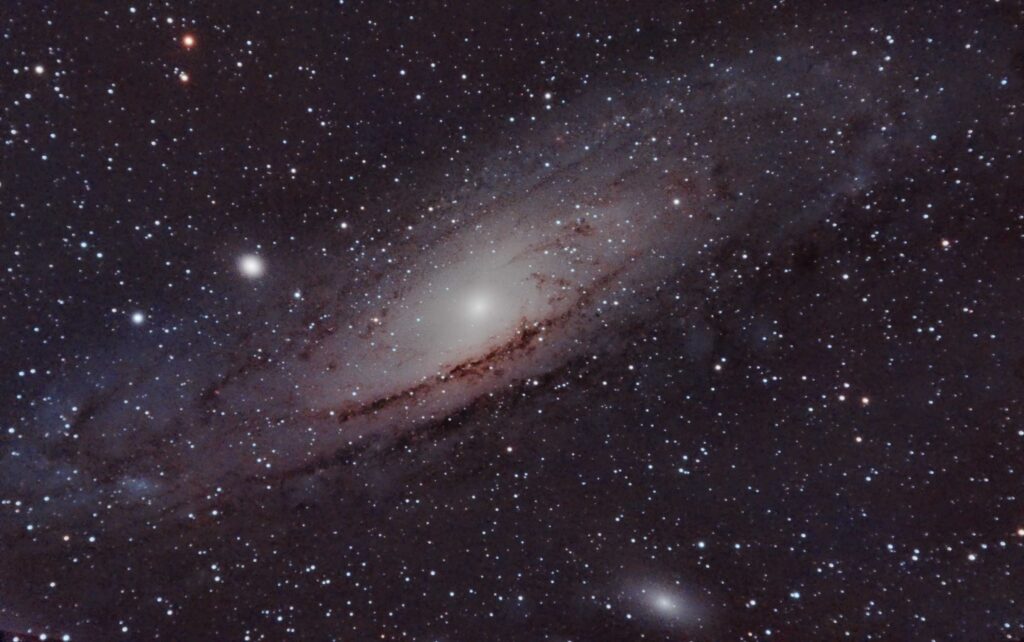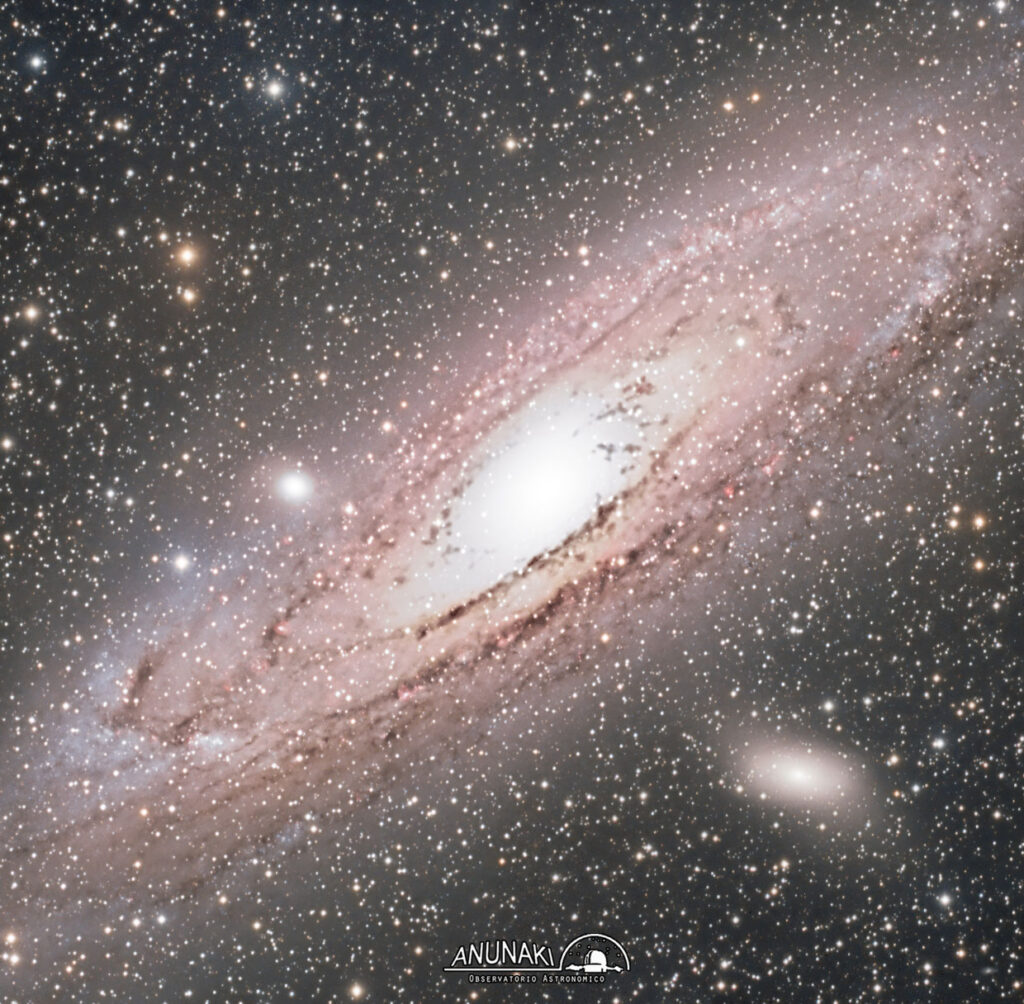The Andromeda Galaxy, also known as Spiral Galaxy M31, Messier 31 or NGC 224, is a spiral galaxy with a diameter of two hundred and twenty thousand light years (as far as its galactic halo is concerned) and about one hundred and fifty thousand light years between the ends of its arms.
It is the farthest object visible to the naked eye on Earth.
It is 2.5 million light-years in the direction of the constellation Andromeda. It is, along with our own galaxy, the largest and brightest of the Local Group galaxies, consisting of about 30 small galaxies plus three large spiral galaxies: Andromeda, the Milky Way, and the Triangle Galaxy.

Technical data:
Telescope: SkyWatcher ED80
Camera: Canon 40D
Focal Length Reducer: SW 0.8x
Telescope Guide: SW 60mm
Mount: LX200 GPSR
Guide CCD: QHY5
Location: Anunaki Observatory / Rivas Vaciamadrid (Madrid)
For many years the accepted value of the distance to Andromeda was around 700 kiloparsecs, based on the study of its Cepheid variables; however, due to the lack of good knowledge of the distance to the Large Magellanic Cloud, this estimate had some margin of error. More recent research that has used not only such stars but other methods such as measurements of how their surface brightness varies, the apparent brightness of their most luminous red giants, and finally the brightness variations of two eclipsing double stars located in it have allowed to determine an average distance of 775 kiloparsecs (about 2.5 million light years).

Technical data:
Telescope: S/C 8″
CCD:Atik314L+
Focal Length Reducer: Meade 6.3
Filters: Clear
Telescope Guide: SkyWatcher ED80
Mount: LX200 GPSR
Guide CCCD: QHY5
CCD Temp:-25º
Ambient Temp:0º
Location: Anunaki Observatory / Rivas Vaciamadrid (Madrid)
4×4 mosaic
Andromeda appears to be richer in neutral hydrogen than our galaxy, with a mass of gas estimated at more than 7×109 solar masses – more than double that of our galaxy. However, being larger than it, this implies a lower density of gas and a greater efficiency when it comes to forming stars. In addition, it has much less molecular hydrogen, fewer supergiant stars than our galaxy, and more old low-mass stars, as well as a much lower star formation rate, even in the aforementioned ring of fire, thought to have been more active in forming stars in the past. Even so, it contains some large, bright star associations such as NGC 206. and an abundant population of medium-mass clusters – quite scarce in our galaxy.
A recent study suggests that Andromeda, like our galaxy, is in what is known in the color-magnitude diagram for galaxies as the green valley: an intermediate zone between the red sequence (galaxies that do not form stars, many of them elliptical galaxies) and the blue cloud (galaxies that form stars at a high rate, many of them spiral galaxies), characterized by a progressive decrease in star formation as the gas from which stars are born runs out, calculating that it will end in 5 billion years, even counting on the increase in star formation that will lead to its collision with the Milky Way

Technical data:
Telescope: FSQ106
CCD: FLI Pl16803
Focal reducer: 0.85x
Filter: LRGB+Ha12nm
Guide telescope: ED80
Mount: Paramount MX+
CCD guide: Atik 314L+
CCD Temp:-25º
Location: Anunaki Observatory / Rivas Vaciamadrid (Madrid)
Collecting all the data mentioned above, it is thought that the Andromeda galaxy was born approximately 10 billion years ago as a result of the merger of numerous protogalaxies, which ended up forming its bulge and disk. It is noteworthy that this Andromeda was much smaller than the current one, perhaps only half of massive.
Two billion years later, 8 billion years ago, M31 suffered a violent collision with a smaller galaxy. This process formed both its extended disk and a large part of its globular clusters and the stars in its halo over several billion years and was able to briefly turn it into an Ultraluminous Infrared Galaxy (UNIL) as its rate of star formation skyrocketed.

Technical data:
Telescope: FSQ106 + S/C 203mm
CCD: FLI Pl16803 + ATIK314L+
Focal reducer: 0.85x
Filter: LRGB+Ha12nm
Guide telescope: ED80 SW
Mount: Paramount MX+
CCD Temp:-25º
Location: Anunaki Observatory
Here the las processed of the Andromeda Galaxy, adding LRGB acquired with FSQ106 and Ha acquired with a Skywatcher Ed80. You can see the nebulae of M31.
